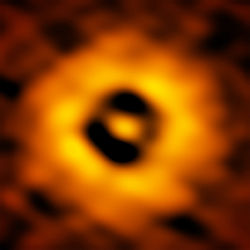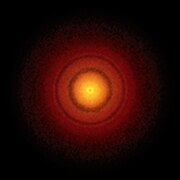TW Hydrae
| Observation data Epoch J2000.0 Equinox J2000.0 | |
|---|---|
| Constellation | Hydra |
| Right ascension | 11h 01m 51.9054s[1] |
| Declination | −34° 42′ 17.0316″[1]> |
| Apparent magnitude (V) | 11.27 ± 0.09[2] |
| Characteristics | |
| Evolutionary stage | Pre-main-sequence |
| Spectral type | K6[2] |
| U−B color index | -0.33[3] |
| B−V color index | 0.67[2] |
| J−H color index | 0.659[2] |
| J−K color index | 0.92[2] |
| Variable type | T Tauri |
| Astrometry | |
| Radial velocity (Rv) | 13.40 ± 0.8[2] km/s |
| Proper motion (μ) | RA: −68.389 ± 0.054[1] mas/yr Dec.: −14.016 ± 0.059[1] mas/yr |
| Parallax (π) | 16.6428 ± 0.0416 mas[1] |
| Distance | 196.0 ± 0.5 ly (60.1 ± 0.2 pc) |
| Details | |
| Mass | 0.8[4] M☉ |
| Radius | 1.11[5] R☉ |
| Luminosity (bolometric) | 0.28[note 1] L☉ |
| Temperature | 4,000[5] K |
| Age | 8[5] Myr |
| Other designations | |
| Database references | |
| SIMBAD | data |
TW Hydrae is a T Tauri star approximately 196 light-years away[1] in the constellation of Hydra (the Sea Serpent). TW Hydrae is about 80% of the mass of the Sun, but is only about 5-10 million years old. The star appears to be accreting from a face-on protoplanetary disk of dust and gas, which has been resolved in images from the ALMA observatory. TW Hydrae is accompanied by about twenty other low-mass stars with similar ages and spatial motions, comprising the "TW Hydrae association" or TWA, one of the closest regions of recent "fossil" star-formation to the Sun.
Stellar characteristics
[edit]
TW Hydrae is a pre-main-sequence star that is approximately 80% the mass of and 111% the radius of the Sun. It has a temperature of 4000 K and is about 8 million years old. In comparison, the Sun is about 4.6 billion years old[7] and has a temperature of 5778 K.[8] The star's luminosity is 28% (0.28x) that of the Sun, equivalent to that of a main-sequence star of spectral type ~K2. However, the spectral class is K6.
The star's apparent magnitude, or how bright it appears from Earth's perspective, is 11.27. It is too dim to be seen with the naked eye.
Planetary system
[edit]| Companion (in order from star) | Mass | Semimajor axis (AU) | Orbital period (days) | Eccentricity | Inclination | Radius |
|---|---|---|---|---|---|---|
| b (unconfirmed) | 23.72 M🜨 | 22 | — | — | — | ~4.25 R🜨 |
| Protoplanetary disk | 1–30? AU | — | — | |||
The star is known to host one likely exoplanet, TW Hydrae b.
Protoplanetary disk
[edit]Previously disproven protoplanet
[edit]In December 2007, a team led by Johny Setiawan of the Max Planck Institute for Astronomy in Heidelberg, Germany announced discovery of a planet orbiting TW Hydrae, dubbed "TW Hydrae b" with a minimum mass around 1.2 Jupiter masses, a period of 3.56 days, and an orbital radius of 0.04 astronomical units (inside the inner rim of the protoplanetary disk). Assuming it orbits in the same plane as the outer part of the dust disk (inclination 7±1°[10]), it has a true mass of 9.8±3.3 Jupiter masses.[10][11] However, if the inclination is similar to the inner part of the dust disk (4.3±1.0°[12]), the mass would be 16+5
−3 Jupiter masses, making it a brown dwarf.[12] Since the star itself is so young, it was presumed this is the youngest extrasolar planet yet discovered, and essentially still in formation.[13]
In 2008 a team of Spanish researchers concluded that the planet does not exist: the radial velocity variations were not consistent when observed at different wavelengths, which would not occur if the origin of the radial velocity variations was caused by an orbiting planet. Instead, the data was better modelled by starspots on TW Hydrae's surface passing in and out of view as the star rotates. "Results support the spot scenario rather than the presence of a hot Jupiter around TW Hya".[14] Similar wavelength-dependent radial velocity variations, also caused by starspots, have been detected on other T Tauri stars.[15]
New study of more distant planet
[edit]In 2016, ALMA found evidence that a possible Neptune-like planet was forming in its disk, at a distance of around 22 AU.[16]
Detection of methanol
[edit]In 2016, methanol, one of the building blocks for life, was detected in the star's protoplanetary disk.[17][18][19][20][21][22][23][24]
Gallery
[edit]- Shadow moving counterclockwise around a gas and dust disc.[25]
- Simulation based on Hubble observations.
- TW Hydrae protoplanetary disc.
- This illustration is based on NASA/ESA Hubble Space Telescope images of a gas and dust discs encircling the young star TW Hydrae.
- This artist’s impression video shows the protoplanetary disc around TW Hydrae. The organic molecule methyl alcohol (methanol) has been found in this disc.
Notes
[edit]- ^ From , where is the luminosity, is the radius, is the effective surface temperature and is the Stefan–Boltzmann constant.
References
[edit]- ^ Jump up to: a b c d e f Brown, A. G. A.; et al. (Gaia collaboration) (August 2018). "Gaia Data Release 2: Summary of the contents and survey properties". Astronomy & Astrophysics. 616. A1. arXiv:1804.09365. Bibcode:2018A&A...616A...1G. doi:10.1051/0004-6361/201833051. Gaia DR2 record for this source at VizieR.
- ^ Jump up to: a b c d e f "V* TW Hya". SIMBAD. Centre de données astronomiques de Strasbourg. Retrieved 2014-01-02.
- ^ Mermilliod, J.C. (1991), "Homogeneous Means in the UBV System", VizieR On-line Data Catalog, Institut d'Astronomie, Universite de Lausanne, Bibcode:2006yCat.2168....0M.Vizier catalog entry
- ^ Chunhua, Qi; et al. (August 2013). "Imaging of the CO Snow Line in a Solar Nebula Analog". Science. 341 (6146): 630–632. arXiv:1307.7439. Bibcode:2013Sci...341..630Q. doi:10.1126/science.1239560. PMID 23868917. S2CID 23271440.
- ^ Jump up to: a b c Rhee, J.H.; et al. (May 2007), "Characterization of dusty debris disks: the IRAS and Hipparcos catalogs", The Astrophysical Journal, 660 (2): 1556–1571, arXiv:astro-ph/0609555, Bibcode:2007ApJ...660.1556R, doi:10.1086/509912, S2CID 11879505.Vizier catalog entry
- ^ Rucinski, Slavek M.; Matthews, Jaymie M.; Kuschnig, Rainer; Pojmanski, Grzegorz; Rowe, Jason; Guenther, David B.; Moffat, Anthony F. J.; Sasselov, Dimitar; Walker, Gordon A. H.; Weiss, Werner W. (December 2008). "Photometric variability of the T Tauri star TW Hya on time-scales of hours to years". Monthly Notices of the Royal Astronomical Society. 391 (4): 1913–1924. arXiv:0809.3987. Bibcode:2008MNRAS.391.1913R. doi:10.1111/j.1365-2966.2008.14014.x.
- ^ Fraser Cain (16 September 2008). "How Old is the Sun?". Universe Today. Retrieved 19 February 2011.
- ^ Fraser Cain (15 September 2008). "Temperature of the Sun". Universe Today. Retrieved 19 February 2011.
- ^ Tsukagoshi, Takashi; Nomura, Hideko; Muto, Takayuki; Kawabe, Ryohei; Ishimoto, Daiki; Kanagawa, Kazuhiro D.; Okuzumi, Satoshi; Ida, Shigeru; Walsh, Catherine; Millar, Tom J. (2016). "A Gap with a Deficit of Large Grains in the protoplanetary disk around TW Hya". The Astrophysical Journal. 829 (2): L35. arXiv:1605.00289. Bibcode:2016ApJ...829L..35T. doi:10.3847/2041-8205/829/2/L35. S2CID 41738556.
- ^ Jump up to: a b Setiawan, J.; Henning, Th.; Launhardt, R.; Müller, A.; Weise, P.; Kürster, M. (3 January 2008). "A young massive planet in a star–disk system". Nature. 451 (7174): 38–41. Bibcode:2008Natur.451...38S. doi:10.1038/nature06426. PMID 18172492. S2CID 4431370.
- ^ McKee, Maggie (2 January 2008). "First planet discovered around a youthful star". NewScientist.com news service. Retrieved 2008-01-02.
- ^ Jump up to: a b Pontoppidan, Klaus M.; et al. (2008). "Spectro-astrometric imaging of molecular gas within protoplanetary disk gaps". The Astrophysical Journal. 684 (2): 1323–1329. arXiv:0805.3314. Bibcode:2008ApJ...684.1323P. doi:10.1086/590400. S2CID 15445587.
- ^ "A young extrasolar planet in its cosmic nursery: Astronomers from Heidelberg discover planet in a dusty disk around a newborn star". Max Planck Institute for Astronomy. 2008-01-02. Retrieved 2008-01-03.
- ^ Huelamo, N.; et al. (2008). "TW Hydrae: evidence of stellar spots instead of a Hot Jupiter". Astronomy and Astrophysics. 489 (2): L9–L13. arXiv:0808.2386. Bibcode:2008A&A...489L...9H. doi:10.1051/0004-6361:200810596. S2CID 18775872.
- ^ Prato, L.; et al. (2008). "A Young Planet Search in Visible and IR Light: DN Tau, V836 Tau, and V827 Tau". The Astrophysical Journal. 687 (2): L103–L106. arXiv:0809.3599. Bibcode:2008ApJ...687L.103P. doi:10.1086/593201. S2CID 14888302.
- ^ "Astronomers discover signs of planet being born around a star". Independent.co.uk. 14 September 2016. Archived from the original on 2022-05-26.
- ^ "Methanol, a Building Block of Life, Found Around Newborn Star for 1st Time". Space.com. 17 June 2016.
- ^ Astrophysics, Harvard-Smithsonian Center for (2016-06-20). "ALMA Reveals Methanol in the TW Hydrae Protoplanetary Disk". SciTechDaily. Retrieved 2021-08-06.
- ^ "Methanol Detected in Protoplanetary Disc around Young Star TW Hydrae | Astronomy | Sci-News.com". Breaking Science News | Sci-News.com. 15 June 2016. Retrieved 2021-08-06.
- ^ "NASA Astrobiology". astrobiology.nasa.gov. Retrieved 2021-08-06.
- ^ "First Detection of Methyl Alcohol in a Planet-forming Disk". National Radio Astronomy Observatory. Retrieved 2021-08-06.
- ^ Dockrill, Peter (16 June 2016). "Scientists Just Discovered Methyl Alcohol in a Nearby Planet-Forming Disc". ScienceAlert. Retrieved 2021-08-06.
- ^ Report, Science World (2017-05-29). "Methanol Discovered For The First Time In The Protoplanetary Disk Of Young Star 'TW Hydra'". Science World Report. Retrieved 2021-08-06.
- ^ "A Molecule For Life Has Been Found Inside A Nearby Planetary Nursery". NDTV.com. Retrieved 2021-08-06.
- ^ "Shadow on TW Hydrae's disc". www.spacetelescope.org. Retrieved 12 January 2017.
External links
[edit]- "Hubble's infrared eyes home in on suspected extrasolar planet". NASA. Hubble Space Telescope. Retrieved 2008-06-24.
- "Notes for star TW Hya and possible planet TW Hya b". Extrasolar Planets Encyclopaedia. Retrieved 2014-01-06.

![Shadow moving counterclockwise around a gas and dust disc.[25]](http://upload.wikimedia.org/wikipedia/commons/thumb/3/38/Shadow_on_TW_Hydrae%E2%80%99s_disc.jpg/180px-Shadow_on_TW_Hydrae%E2%80%99s_disc.jpg)







